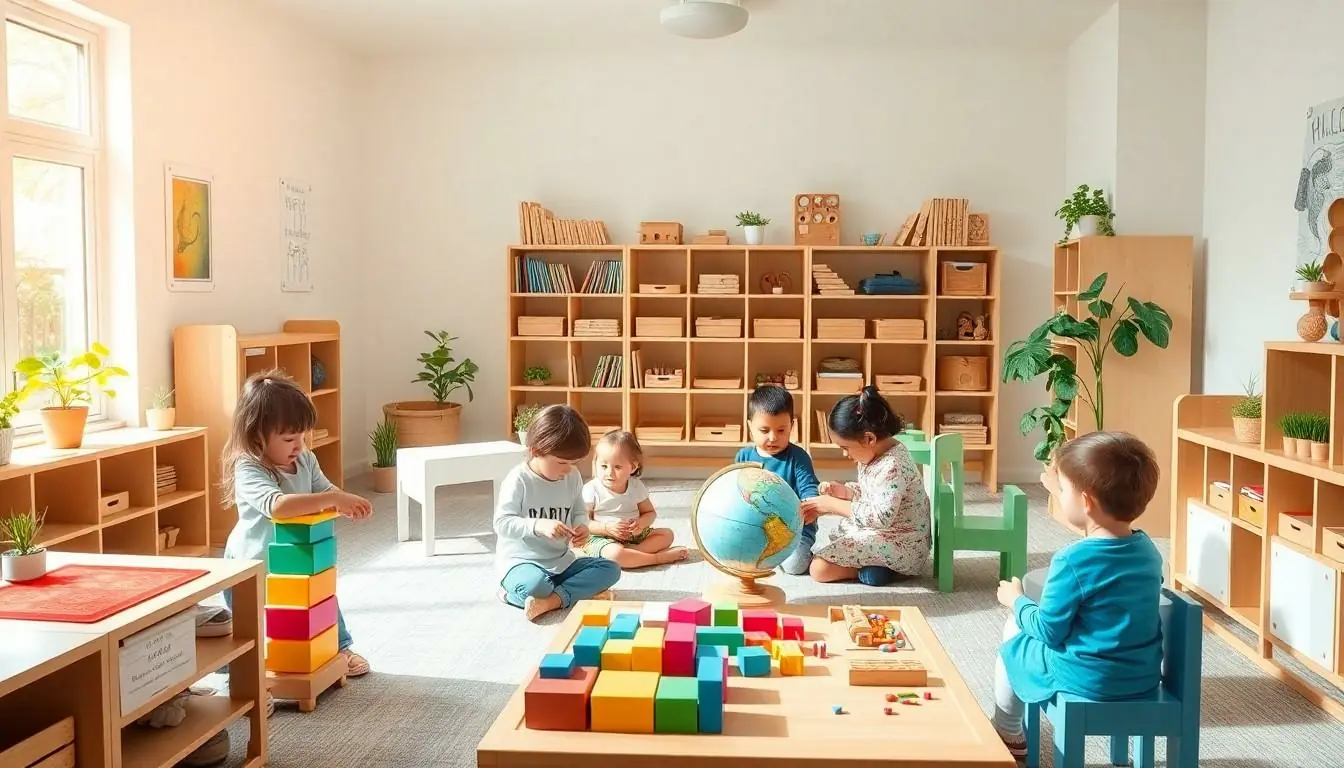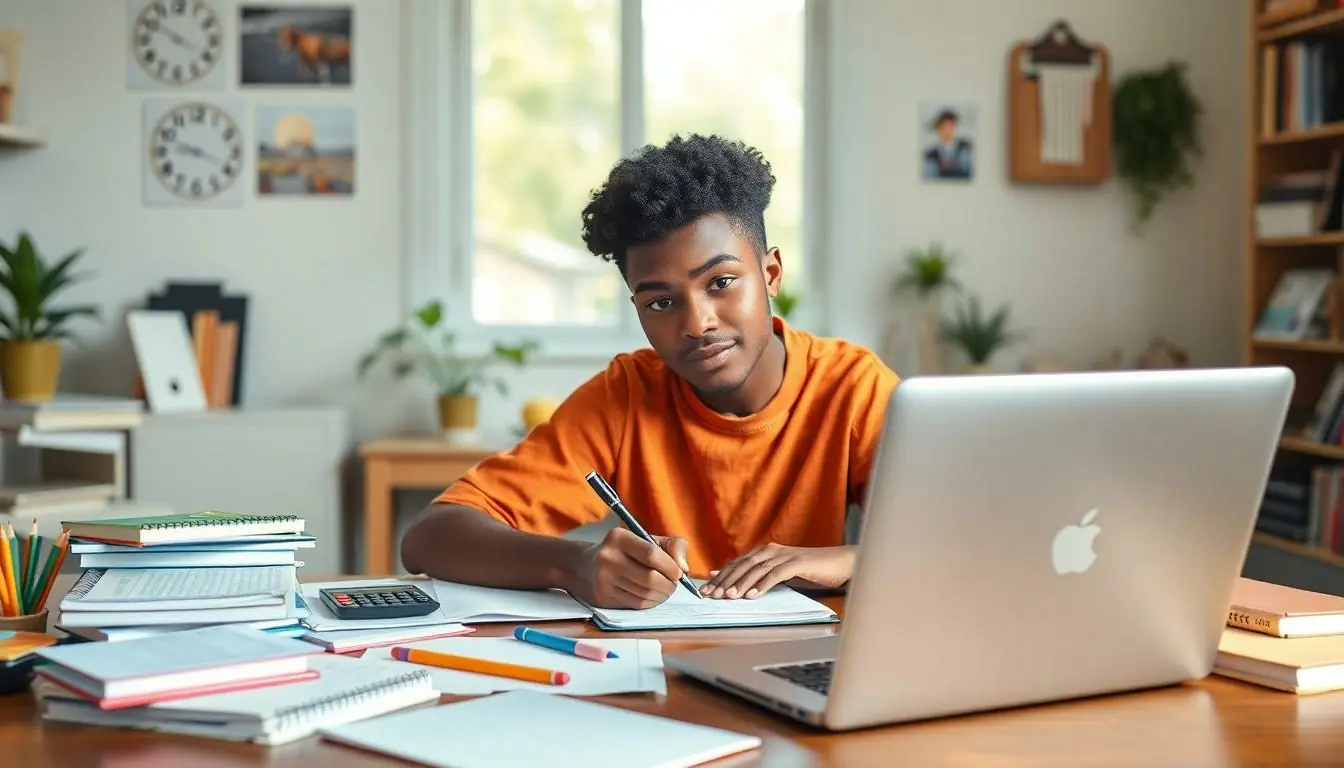When it comes to early childhood education, parents often find themselves in a friendly boxing match between two heavyweight champions: the Reggio Emilia approach and the Montessori method. Both educational philosophies have earned their stripes in nurturing young minds, but they’re as different as spaghetti and sushi.
These innovative teaching approaches have revolutionized early childhood education, each with its unique recipe for success. While Montessori focuses on structured independence and self-directed learning, Reggio Emilia embraces a more fluid, project-based philosophy where children become the authors of their own educational journey. As parents navigate these choices, they’ll discover that both methods share a profound respect for children’s capabilities while taking distinctly different paths to foster growth and development.
Table of Contents
ToggleUnderstanding Reggio Emilia and Montessori Methods
The Reggio Emilia approach and Montessori method emerged from distinct historical contexts in Italy, shaping their unique educational philosophies. Each approach offers different perspectives on child development, learning environments and teaching methodologies.
Historical Origins
Maria Montessori developed her educational method in 1907 in Rome’s low-income neighborhoods, opening the first Casa dei Bambini (Children’s House). Her scientific background as Italy’s first female physician influenced her systematic observation of children’s learning patterns.
The Reggio Emilia approach originated in the aftermath of World War II in the Italian city of Reggio Emilia. Educator Loris Malaguzzi collaborated with local parents in 1945 to create a new educational system focused on rebuilding their community. The approach gained international recognition in the 1980s when Newsweek magazine named the Diana School in Reggio Emilia one of the best educational systems worldwide.
Core Educational Philosophies
The Montessori method centers on structured independence through prepared environments with specific materials designed for developmental stages. Children engage in uninterrupted work periods using scientifically designed learning materials that isolate specific skills. The teacher acts as an observer and guide rather than a traditional instructor.
The Reggio Emilia approach views children as protagonists of their learning journey. Teachers document children’s work through photos, videos and transcripts to make learning visible. The environment serves as the “third teacher” alongside educators and parents, encouraging exploration through art, nature and collaborative projects. Children express their understanding through multiple symbolic languages including drawing, sculpture, dramatic play and writing.
The Role of Teachers and Environment
The teacher’s role and classroom environment differ significantly between Reggio Emilia and Montessori approaches. Each methodology creates distinct learning spaces that reflect their core educational philosophies.
Teacher Involvement Across Methods
Montessori teachers function as observers and guides, stepping back to allow children’s independent exploration of materials. They demonstrate the use of specific materials when needed, then observe as children work independently. Teachers maintain detailed records of each student’s progress through developmental milestones.
Reggio Emilia teachers act as co-learners alongside children, actively participating in investigations and projects. They document children’s work through photos, videos and written observations to make learning visible. These educators collaborate with colleagues to analyze documentation and plan future learning experiences based on children’s interests.
Classroom Setup and Materials
Montessori classrooms feature carefully arranged learning areas with specific materials designed for different developmental stages. Each material serves a precise purpose and includes built-in error control mechanisms. The environment contains child-sized furniture, practical life activities, sensorial materials, math manipulatives and language materials.
Reggio Emilia spaces incorporate natural light, flexible spaces and varied materials for creative expression. The environment includes art studios (ateliers), documentation panels displaying children’s work and projects, mirrors at child height and open-ended materials like clay, wire, paint and recycled items. Classrooms connect to outdoor spaces that extend learning opportunities.
| Feature | Montessori | Reggio Emilia |
|---|---|---|
| Materials | Specific prescribed materials | Open-ended materials |
| Space Organization | Fixed learning areas | Flexible spaces |
| Documentation | Individual progress records | Project documentation panels |
| Environment | Structured prepared environment | Adaptable creative spaces |
Curriculum and Learning Approaches
The curriculum structures of Montessori and Reggio Emilia approaches reflect distinct philosophies in early childhood education. Each method implements unique strategies for learning development based on their core educational principles.
Child-Led vs. Structured Learning
Montessori education follows a structured curriculum with specific materials for each developmental stage. Children engage with Montessori materials like counting beads sensorial blocks math rods in a predetermined sequence. The classroom offers 5 core areas: Practical Life Sensorial Language Mathematics Cultural Studies.
The Reggio Emilia approach embraces emergent curriculum based on children’s interests. Teachers develop projects from observing children’s play discussions questions. A single topic exploration extends across multiple subjects lasting weeks or months. Children express ideas through 100 languages including drawing painting sculpture dramatic play music.
Documentation and Assessment Methods
Montessori teachers track progress through detailed observation checklists skills mastery records. Each child’s work receives documentation in portfolios containing completed activities developmental milestones achievement records. Teachers use specific assessment tools to evaluate proficiency in practical life skills mathematical concepts language development.
Reggio Emilia documentation captures learning through photos videos transcripts artwork. Teachers collect daily observations children’s conversations work samples project developments. This documentation adorns classroom walls creating visible learning experiences. Parents receive regular updates through digital portfolios classroom displays project narratives.
| Assessment Element | Montessori | Reggio Emilia |
|---|---|---|
| Primary Tools | Checklists Skills Records | Photos Videos Transcripts |
| Focus Areas | Individual Achievement | Group Project Progress |
| Documentation Style | Structured Portfolios | Visual Learning Stories |
| Parent Communication | Progress Reports | Daily Documentation Sharing |
Creative Expression and Art
The Montessori and Reggio Emilia approaches embrace distinct philosophies toward creative expression and artistic development. Their contrasting methods shape how children explore creativity and develop artistic skills in early education settings.
Art Materials and Projects
Montessori classrooms provide specific art materials organized in designated areas, including colored pencils, watercolors, and clay. Children access these materials independently during work periods, following structured lessons on proper techniques and material care. The art activities focus on skill development through individual exploration of concepts like color mixing, line drawing, or textile work.
Reggio Emilia environments feature diverse, open-ended art materials displayed in accessible ateliers (art studios). Materials include natural items, recycled objects, digital tools, light tables, and traditional art supplies. Projects emerge from children’s interests and often integrate multiple media types, encouraging collaborative exploration of ideas through various artistic expressions.
Documentation of Creative Process
Montessori teachers record individual progress in art skills through observation checklists and portfolios. Each child’s artwork remains separate, documenting their personal growth in technical abilities and creative expression over time.
Reggio Emilia educators capture the creative journey through photographs, videos, and written narratives displayed throughout the classroom. Documentation panels showcase group projects, revealing children’s theories, dialogues, and artistic transformations. Teachers collect sketches, photographs, and transcribed conversations to make the learning process visible to children, families, and fellow educators.
- Cameras for capturing work stages
- Voice recorders for discussions
- Display boards for project progression
- Digital tablets for multimedia documentation
- Portfolios containing process samples
Social Development and Community
Social development forms a cornerstone in both educational approaches, though they differ significantly in their implementation methods. Each philosophy emphasizes distinct aspects of community building and social interaction.
Parent Involvement
Montessori schools maintain structured parent communication through scheduled conferences, observation opportunities, and specific volunteer roles. Parents receive detailed progress reports focusing on individual skill development and academic achievements. In contrast, Reggio Emilia schools integrate parents as essential co-creators of the learning environment. Parents participate directly in project planning, documentation panels, and classroom activities. The Reggio approach views families as integral partners who contribute expertise, materials, and cultural perspectives to enrich the learning experience. Regular family meetings, collaborative events, and community projects create multiple touchpoints for engagement.
Group Learning Dynamics
Montessori classrooms foster independence through mixed-age groupings spanning three years, enabling peer teaching and mentorship opportunities. Children work primarily on individual activities, choosing their materials and pace while developing social skills through natural interactions. The Reggio Emilia approach emphasizes collaborative small-group projects where children explore concepts together. Teachers document group discussions, negotiate project directions, and facilitate peer interactions. These group investigations often extend for weeks or months, allowing deep exploration of topics through multiple perspectives. Social learning occurs naturally as children share ideas, solve problems, and create collective representations of their understanding.
Key Differences Between Reggio Emilia and Montessori
The Reggio Emilia and Montessori approaches differ significantly in their educational methodologies. These differences manifest across various aspects, from age groupings to material selection.
Age Group Focus
Montessori education serves children from birth through adolescence, with specific programs for each developmental stage:
- Infant/Toddler Programs (0-3 years)
- Primary Programs (3-6 years)
- Elementary Programs (6-12 years)
- Secondary Programs (12-18 years)
Reggio Emilia programs focus on early childhood education:
- Infant Programs (0-3 years)
- Preschool Programs (3-6 years)
- Kindergarten Programs (5-7 years)
Teaching Materials and Resources
Montessori classrooms feature standardized materials:
- Precisely designed manipulatives
- Self-correcting materials
- Sequential learning tools
- Specialized equipment for practical life exercises
- Natural materials (wood, stones, plants)
- Recycled items
- Art supplies
- Light tables
- Documentation tools (cameras, recording devices)
- Project materials based on current investigations
| Material Type | Montessori | Reggio Emilia |
|---|---|---|
| Structure | Standardized | Flexible |
| Source | Manufactured | Natural/Recycled |
| Purpose | Skill-specific | Open-ended |
| Availability | Permanent | Rotational |
Choosing Between Reggio Emilia and Montessori
Selecting the right educational approach depends on understanding how each method aligns with a child’s learning style and family values. Parents benefit from evaluating specific aspects of both approaches to make an informed decision.
Questions to Consider
- Does your child prefer structured activities or open-ended exploration?
- What role do you expect to play in your child’s education?
- How important is academic preparation versus creative expression?
- What type of classroom environment supports your child’s learning style?
- Is individual progress tracking or project-based documentation more valuable?
- Does your child thrive in mixed-age groups or same-age peer settings?
- How much flexibility do you desire in the curriculum?
- What are your expectations for parent involvement?
Best Fit for Different Children
Montessori education supports children who:
- Excel at independent work
- Follow structured routines
- Learn through hands-on manipulation
- Prefer working at their own pace
- Focus well in quiet environments
- Enjoy mastering specific skills
- Thrive in collaborative settings
- Express ideas through multiple mediums
- Adapt well to changing projects
- Engage actively in group discussions
- Learn through social interaction
- Respond to flexible schedules
Conclusion
Both the Montessori and Reggio Emilia approaches offer unique benefits for early childhood education. While Montessori provides structured independence and clear developmental pathways Reggio Emilia embraces fluid project-based learning and collaborative exploration.
The right choice depends largely on a child’s individual needs learning style and family values. Parents should observe their child’s preferences for structured versus open-ended activities their social inclinations and how they best engage with learning materials.
Remember that there’s no one-size-fits-all solution in early childhood education. What matters most is finding an approach that resonates with both the child and family while supporting optimal growth and development.


